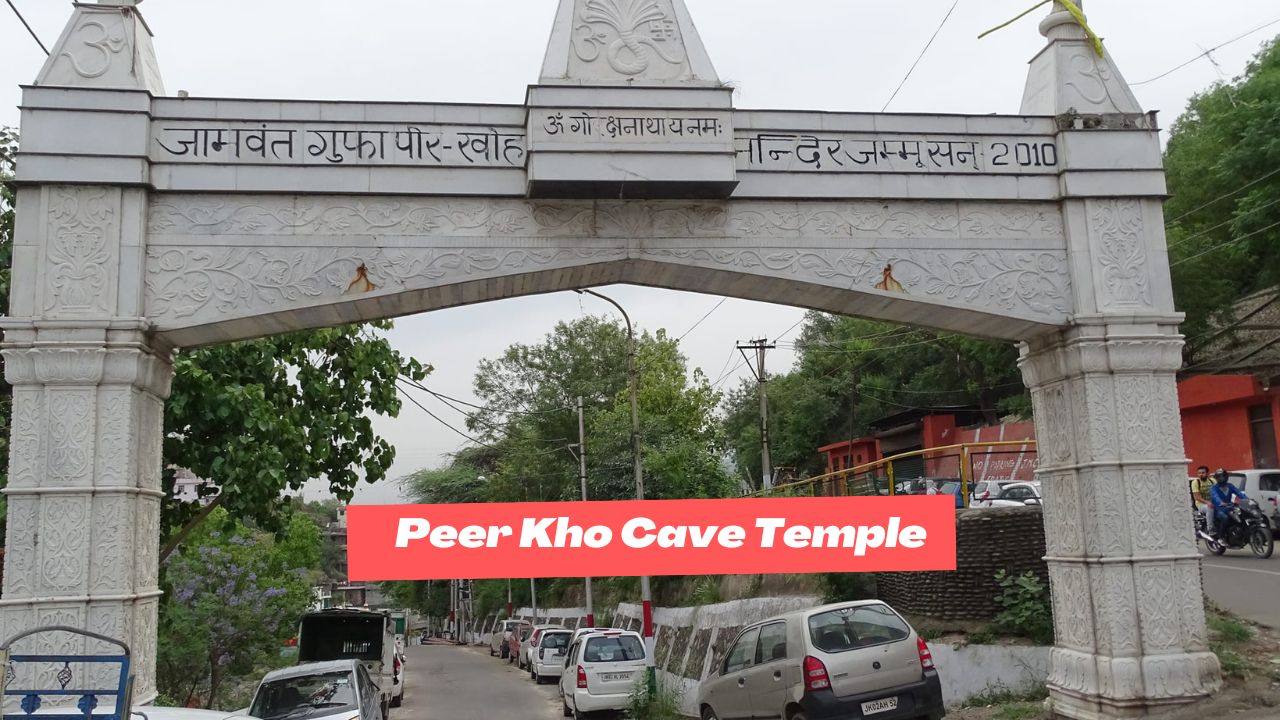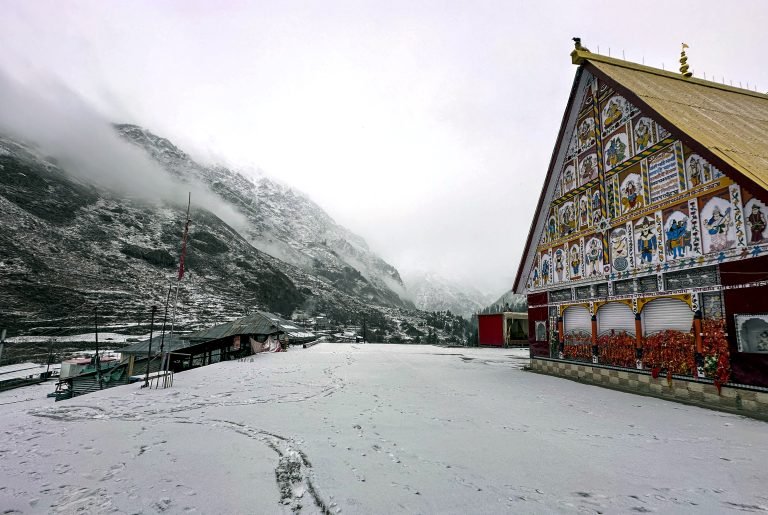The mystical Jamwant Cave Shrine, also known as Peer Kho Cave Temple Jammu, is a treasure trove of history and spirituality. Nestled on the north-eastern outskirts of Jammu, along the Circular Road on the right bank of the serene Tawi River, this sacred site is a unique landmark. It is not just a revered Shiva shrine but also the only one in India dedicated to Jamwant, a legendary figure from the epic Ramayana. The shrine attracts thousands of devotees and tourists daily, making it an integral part of Jammu’s cultural and religious virasat.
Read also: Register for Shri Mata Vaishno Devi Yatra at Katra Railway Station: A Step-by-Step Guide
The Legend of Peer Kho Cave Temple Jammu
The cave shrine houses a natural Shivlingam and an idol of Jamwant, the king of bears, who played a pivotal role alongside Sugriva in helping Lord Rama defeat Ravana in the Ramayana. According to local lore, Jammu itself derives its name from this cave, underscoring its historical significance.
It is also said that during the reign of Raja Biram Dev of Jammu (1454-95) a famous meditation Jogi Guru Garib Nath belonging to the Guru Gorakh Nath order came to Jammu and resided in Peerkho.
Devotees throng this shrine, especially during the auspicious festival of Mahashivratri. On this day, the shrine comes alive with vibrant celebrations, including a traditional fair. Pilgrims begin queuing in the early hours to seek blessings from Lord Shiva and honor Jamwant. The sanctum sanctorum, located underground, is accessed via steep stairs that lead worshippers into the heart of this sacred space.
Read also: Best Shopping Places in Jammu City
Mahashivratri Celebrations and Preparations
Mahashivratri, one of the most significant Hindu festivals, is a grand occasion at the Jamwant Cave Shrine. Preparations begin well in advance, with the shrine undergoing a complete facelift. Whitewashing, painting, and other renovations ensure the shrine is ready to welcome thousands of visitors. Tourism Department along with District Administration, Jammu and Peer Kho Mandir Committee organises Maha Shivratri Festival at Peer Kho, the festival shall host a variety of programmes which inter alia include cultural events depicting local folk dances by artists.
Peer Kho Cave Temple Jammu: A Name Rooted in Myths and Legends
There are multiple theories about how Jammu got its name. While one popular belief ties it to King Jambu Lochan, who ruled the region during Kaliyuga, another attributes it to Jamwant. Many locals hold firm to the latter theory, emphasizing the cave’s historical and spiritual importance.
Beyond its legends, the Jamwant Cave Shrine serves as a pilgrimage spot for devotees visiting Mata Vaishno Devi. Mondays, in particular, witness a surge in visitors, as they are considered auspicious for Lord Shiva worship. The shrine is also closely associated with Guru Gorakhnath, who is believed to have meditated here, adding another layer of sanctity to this revered site.

Kho means cave in Dogri. He came to be known as Peer-i-Kho and thus with the passage of time the cave got its name. The cave is also known as the Jamavant Guffa as the bear hero of Ramayana is believed to have meditated in Guffa.
Jamwant: A Mythological Connection
The shrine’s historical roots are intertwined with fascinating myths. Jamwant, after aiding Lord Rama in his victory over Ravana, is said to have traveled to the Himalayas and settled in this cave for meditation. Here, he established the natural Shivlingam, dedicating himself to Lord Shiva.
Read also: All About Shri Machail Mata Yatra: A Divine Pilgrimage in the Heart of Kishtwar
Another popular legend recounts an encounter between Jamwant and Lord Krishna. The two engaged in a fierce battle when Lord Krishna sought a precious gem, the Mani, believed to be in Jamwant’s possession. Upon recognizing Lord Krishna as an incarnation of Lord Vishnu, Jamwant surrendered the Mani and offered his adopted daughter, Jamwanti, in marriage to Krishna. Jamwanti’s name is often mentioned in scriptures as one of Krishna’s queens.
Exploring the Shrine’s Architecture
The Peer Kho Temple presently comprises of two caves. Both these caves are at a depth of about 20 to 30 feet from the ground level of the temple complex. A flight of marble steps leads on to the first cave. It is not possible to cross the cave without bending. One has to stoop to cover the 15 feet long and 3 feet wide cave. At the end of this cave tunnel there is a larger cave. The naturally formed black colored Shiva Lingam is the focal point of this pentagonal cave which is 12 feet in height. This makes it possible for devotees to stand comfortably within the interiors of this particular cave to offer their prayers.
The Jamwant Cave Shrine is modest in size yet steeped in spiritual energy. To enter the cave, visitors descend approximately 15 steps into an underground chamber. The cave stretches 20 meters in length and is about 2 meters wide, with two distinct sections. The northern chamber houses the sacred Shivlingam, while the southern chamber features the idol of Jamwant.
Perched on a hill slope, the shrine offers a serene environment, perfect for reflection and worship. Its connection to Guru Gorakhnath further elevates its significance, as it is considered one of his prominent seats in India. The temple’s courtyard exudes tranquillity, with a Tulsi plant standing sentinel, reminiscent of Dogra architectural styles. A unique feature of the temple is the continuous smoke-emitting shrine at its centre, adding to its mystical allure. The temple is built on an elevated platform safeguarding it against floods from the Tawi River.
Why Visit the Jamwant Cave Shrine?
Whether you are a devotee, a history enthusiast, or a curious traveler, the Jamwant Cave Shrine offers a unique blend of mythology, spirituality, and cultural heritage. Its association with Lord Shiva, Jamwant, and Guru Gorakhnath makes it a must-visit destination in Jammu.
Read also: All About Basohli Pashmina Shawl and Muffler
The shrine is not just a place of worship but a testament to Jammu’s rich historical tapestry. From its legendary ties to its serene surroundings, it encapsulates the essence of devotion and tranquility. Visiting the shrine, especially during Mahashivratri, offers an unforgettable experience, connecting you to the divine and the region’s ancient traditions.
One can also enjoy 1.18 km long Peerkho -Mahamaya section of Jammu ropeway, a major tourist attraction which will instill new enthusiasm in Jammu’s tourism sector, connecting three major temples of Jammu city viz Peerkho, Mahamaya and Bahu, to generate direct & indirect livelihood opportunities for the locals.
Road Map To Peer Kho Cave Temple Jammu
Plan Your Visit
For those planning a visit, the shrine is easily accessible from the city center. Its proximity to other famous destinations, such as Mata Vaishno Devi, makes it an ideal addition to your itinerary. Remember to visit on a Monday or during Mahashivratri for an enhanced spiritual experience.
Best Time to Visit
The ideal time to visit Peer Kho is during Shivratri or Navratri festivals. For a peaceful experience, visit between October and March when the weather is cool and pleasant.
Discover the magic of the Jamwant Cave Shrine and immerse yourself in the legends that shaped the history and culture of Jammu.
















